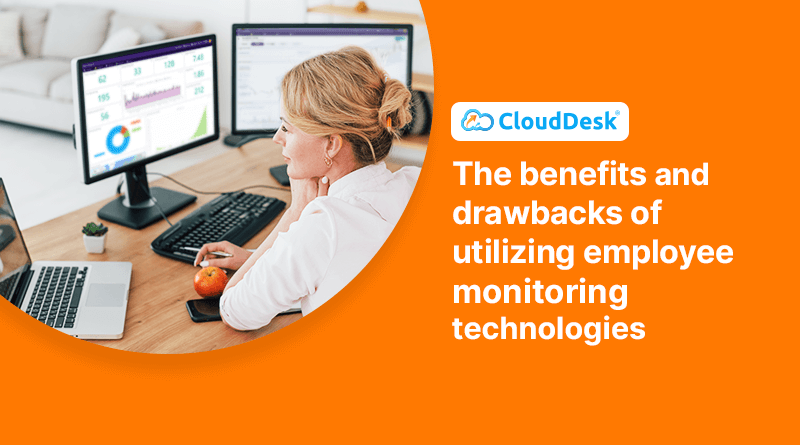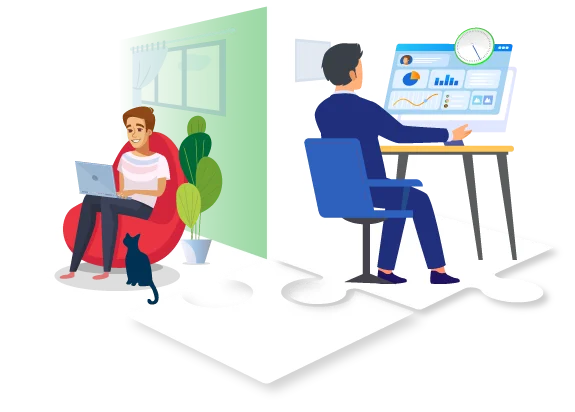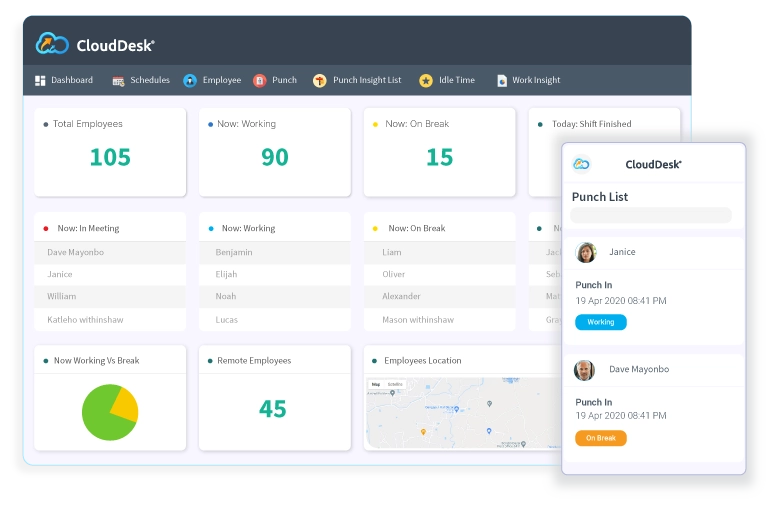When Jubair Bin Kibria first began utilizing productivity tracking software, he was hesitant. At the time, Bin Kibria was working as a solution delivery expert and a VP for the No-Code startup CloudApper. To keep everyone on the same page, senior management used CloudDesk, a software-as-a-service platform that enabled managers to monitor staff activities and… Continue reading The benefits and drawbacks of utilizing employee monitoring technologies
The benefits and drawbacks of utilizing employee monitoring technologies

When Jubair Bin Kibria first began utilizing productivity tracking software, he was hesitant. At the time, Bin Kibria was working as a solution delivery expert and a VP for the No-Code startup CloudApper. To keep everyone on the same page, senior management used CloudDesk, a software-as-a-service platform that enabled managers to monitor staff activities and progress levels remotely. As a manager, Bin Kibria in Dhaka was simultaneously watching his staff and being supervised by superiors.
It didn’t take him long to make up his mind. It was a welcomed change. Bin Kibria had always worked from both remotely as well as in office. Before CloudDesk, Bin Kibria was frequently engaged in tasks that did not have very clear, defined timetables. There has always been a heavy focus on the need to be self-managed, so the introduction of this technology provided him the ability to track overall progress and time spent in administrative tasks, performing quality assurance tasks, and in customer and team communication tasks.
The CloudDesk technology takes screenshots of workers’ displays, which managers can then review. Bin Kibria discovered that turning on time awareness increased his productivity so much that he now tracks his own work using CloudDesk.
As more people work from home, some businesses are resorting to fresh tactics and technology to remotely monitor their workers. Managers may monitor workers’ productivity and activity using software tools that provide anything from virtual time clocks to email and chat monitoring to work computer-use tracking.
It’s a undeniable trend that software and monitoring tools for remote workers is a significant and expanding industry. Amazon, Google, and Microsoft, along with hundreds of other firms, are providing tools that enterprises can use to track employee productivity. Organizations may pay between $5 and $30 per person to utilize this technology, and some software firms claim productivity gains of 22% to 32%.
While such software is becoming more popular, they may not always result in a considerable return on investment due to the detrimental effect they may have on staff morale. Long-term HR expenditures will often outweigh IT costs if employee turnover rises or recruitment becomes more difficult as a result. Then, there are the legal and cybersecurity issues associated with data collecting and storage, not to mention the overall apprehension that many people will have while utilizing the device.
Having said that, many managers trust in the technology if it is applied thoughtfully and honestly. As risk managers, however, CFOs and business owners in general should weigh the benefits and drawbacks of utilizing monitoring software, as every business ought to approach monitoring in a specific way set to their business.
Benefits of Monitoring Software
It is critical to differentiate between various kinds of software while keeping your company’s ultimate purpose in mind. Some businesses, for example, merely want to measure productivity. Employee performance has not decreased on average throughout the epidemic, but it’s not inconcievable that a manager may notice productivity decreases from a staff member and want to investigate.
Others are interested in tools that might assist managers in understanding their staff and identify any challenges they may experience when working remotely. “Understanding” staff can mean anything from knowing what hours of the day are most productive to seeing how quickly certain employees complete certain tasks. They are universally concerned, of course, with employee satisfaction, well-being, and overall experience. If, for example, every employee on a team seems to get stuck on a certain activity or procedure, monitoring software may assist leadership in looking at the larger picture and identifying issues to make employees’ work lives easier.
A third objective is to improve communication and connectedness among managers and workers. However, Bin Kibria noted that this may simply be employee surveillance under a new name. The ideal process is that you can simply show up and arrange a meeting, just as you can swing by someone’s desk in person. Any level of monitoring beyond what is possible in a traditional office environment can quickly feel like privacy invasion.
Regardless of intentions, consumption is increasing, and many CEOs claim beneficial results from monitoring employees. This is especially true in firms that wish to provide a flexible working environment and when the majority of employees are permanently remote. These types of leaders believe it is critical to know what their staff are up to.
Potential Cons of Productivity Monitoring Software
While assessing productivity monitoring software, finance, HR, and legal directors should evaluate four key hazards which if not meaningfully addressed, can lead to serious trouble. There are various extra challenges inherent to monitoring software beyond initial costs.
The first is the expense of managers’ relationships with their staff. Using productivity monitoring software might convey the appearance that managers do not trust their staff. If those feelings spread among employees, this can have a detrimental impact on culture and create a distrustful workplace. It only takes one rumor or passing thought to turning monitoring software into a dangerous separator for managers and employees.
Monitoring software can also have several additional financial costs if not managed closely. Employee data must be managed correctly and lawfully. Otherwise, your business will likely face legal and then financial repercussions. This is especially concerning for international organizations, which will be subject to varying data security and privacy legislation in various nations.
Data collecting also poses a security concern. If executives have access to extra sensitive information about their workers, they must be considerably more diligent in defending against hackers or breaches. This means that your business will likely have to further invest in cybersecurity measures. It is also possible that monitoring software may affect your business’s outward appearance. What effect will it have on customers if they realize you’re collecting staff data? Clients may feel uneasy on behalf of workers if the monitoring tactics you use seem to be too invasive. No matter how ethically your managers may be, public perception can quickly outrun good intentions. This sort of reputational harm may also make it more difficult to attract talent in the future.
Gartner anticipates that new regulations restricting the data organizations may acquire about their employees will emerge shortly in several countries. In the United Kingdom, politicians are already talking about the problem after a November 2020 survey found that an increasing number of businesses were implementing the technology.
Best Practices
Before implementing any kind of monitoring software, managers and team leaders ought to have a very specific reason to do so.
If the question is simply, “Are people productive or not?” you may have better (and easier) means to verify this. Further, if you can’t trust your employees to be productive, or to meaningfully report their productivity to you or your managers, you likely have a much bigger problem on your hands. If you are looking for big data on a more trend-based scale, there are real use cases for monitoring software.
If you do decide to use this technology, you should begin by developing your own criteria and best practices, as these will never be the same for any two businesses. Maintain open lines of communication with important partners such as HR, privacy, legal, compliance, IT, and analytics executives throughout your implementation stage. And be sure that the employees being monitored consent to it, as their input is equally important.
The different stakeholders should be asking each other the following questions: What data is used and how is it used? Who has access to the data and where will it be stored? What rules and processes are in place to safeguard our information? What rules and regulations apply to us? When external suppliers are engaged, it is equally critical to pay close attention.
Transparency is essential
There are three steps to successfully implementing productivity monitoring software while maintaining your employees’ trust.
First, be certain employees know they are being watched. Second, explain what you are tracking, why you are tracking it, how that data will be used, and what decisions you will not make with it. Third, clearly state and publish your data and monitoring rules. When you do this, you will discover that the vast majority of employees will likely be content with their employer collecting that information about them.
Need help implementing employee productivity monitoring software for your team? Contact CloudDesk today and our experienced customer success analysts will help you throughout the process.
Similar Posts

Why The Future Of Work Is Remote: Top Reasons and…

Top 5 Tips to Help You Work From Home Successfully




